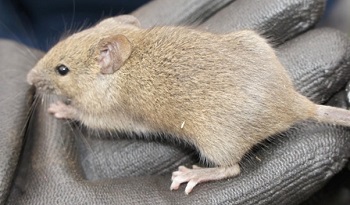








 Recently, Andrew has begun a collaboration with Jan Bradley, to study feral house mice Mus musculusliving on the Isle of May, off the coast of Scotland, near Edinburgh. House mice have been extremely well-studied in the laboratory, and are *THE* model organism in much of biomedical science. Their genetics and immunology are therefore very well understood, but surprisingly they have been the subject of only a handful of studies in the wild. This may be because house mice usually live in close proximity with humans, on farms and in cities. In these circumstances they are considered pests, and are widely trapped and poisoned, making it difficult to make ecological studies of them. Mice on the Isle of May were first recorded in the nineteenth century, but may have been there for much longer. They do well on the island because there is little competition and predation, while seabird guano fertilises the vegetation, and mice may scavenge on dead birds.
Recently, Andrew has begun a collaboration with Jan Bradley, to study feral house mice Mus musculusliving on the Isle of May, off the coast of Scotland, near Edinburgh. House mice have been extremely well-studied in the laboratory, and are *THE* model organism in much of biomedical science. Their genetics and immunology are therefore very well understood, but surprisingly they have been the subject of only a handful of studies in the wild. This may be because house mice usually live in close proximity with humans, on farms and in cities. In these circumstances they are considered pests, and are widely trapped and poisoned, making it difficult to make ecological studies of them. Mice on the Isle of May were first recorded in the nineteenth century, but may have been there for much longer. They do well on the island because there is little competition and predation, while seabird guano fertilises the vegetation, and mice may scavenge on dead birds.
 We have already found that the mice on the May are infected with substantial numbers of both ecto- (mites) and endoparasites (including nematodes and cestodes). There is also substantial variation in immune phenotypes between mice. Although the Isle of May is a small island, the mice are likely to be quite genetically variable, because of an introduction experiment that was carried out there during a previous period of research in the 1980s. Mice from one of the Orkney islands, in the north of Scotland were introduced onto the Isle of May, where they quickly spread, and bred with the existing population, which was thought to have little genetic variation. It will be interesting to follow up the longer term consequences of this introduction, since the population perturbation is likely to have resulted in strong selection.
We have already found that the mice on the May are infected with substantial numbers of both ecto- (mites) and endoparasites (including nematodes and cestodes). There is also substantial variation in immune phenotypes between mice. Although the Isle of May is a small island, the mice are likely to be quite genetically variable, because of an introduction experiment that was carried out there during a previous period of research in the 1980s. Mice from one of the Orkney islands, in the north of Scotland were introduced onto the Isle of May, where they quickly spread, and bred with the existing population, which was thought to have little genetic variation. It will be interesting to follow up the longer term consequences of this introduction, since the population perturbation is likely to have resulted in strong selection.
In a BBSRC grant, with Kathryn Else and John Brookfield, we are now looking at the factors that contribute to variation in immune responses in wild mice, a key question in ecological immunology. Some part of the variation is likely to be genetic (heritable), and we will be able to estimate this from the relatedness between wild individuals, but immune responses are also likely to vary as result of environmental factors like infection, or age. We will use cutting-edge immunological techniques, coupled with experiments to reduce parasitic infections, and detailed ecological characterisation of the mouse population to address our aims.